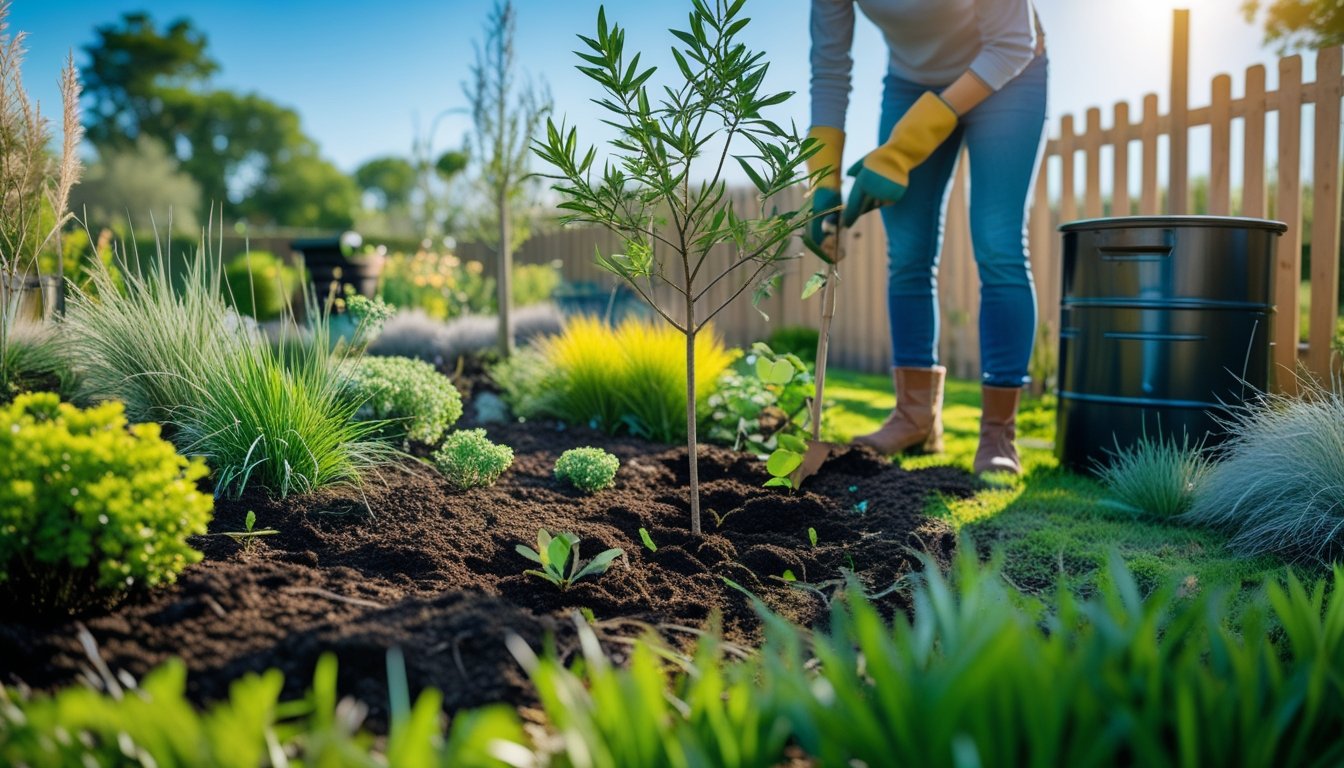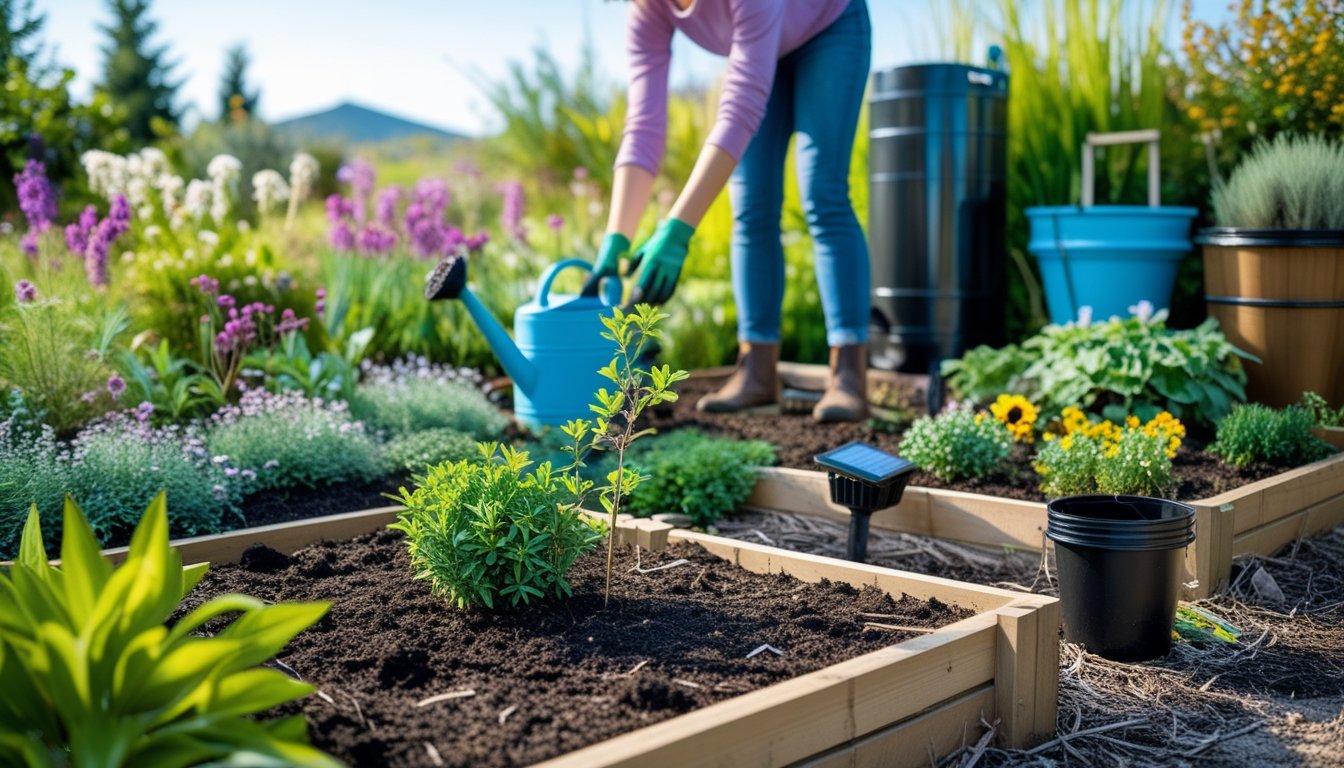Late updated: 04 Sep 2025 14:09
Written by: Sarah Hollister
Sustainable Landscaping Tips For Beginners: Essential Advice For Eco-Friendly Gardens
Embarking on the journey of sustainable landscaping is not only a step towards an eco-friendly lifestyle but also a commitment to cultivating a beautiful, thriving environment. For beginners, focusing on native plants, water conservation, and natural garden design are key steps that lead to both aesthetic and environmental benefits. Incorporating these principles helps us create outdoor spaces that are not only visually appealing but also supportive of local ecosystems.

Utilising sustainable practices doesn't have to be daunting. In fact, it can be quite straightforward and rewarding. By integrating a few essential elements into our gardening routine, such as composting and water-smart irrigation techniques, we contribute positively to our surroundings. These practices ensure that our gardens flourish with minimal environmental impact.
By exploring practical, easy-to-implement tips, we can transform any garden into a sustainable paradise. This journey promises not only personal satisfaction but also the joy of knowing that we're nurturing the planet. Let's delve into the various strategies that can help guide this green transformation.
Key Takeaways
- Integrate native plants and water conservation for effective sustainable landscaping.
- Composting and eco-friendly practices lead to minimal environmental impact.
- Practical tips can transform any garden into a sustainable space.
Core Principles of Sustainable Landscaping
Creating a sustainable landscape requires a thoughtful approach to design, material selection, and gardening practices. By focusing on soil health, garden design, and composting techniques, we can develop beautiful outdoor spaces that are environmentally responsible and easy to maintain.
Assessing Your Outdoor Space
Before diving into sustainable gardening, we must thoroughly evaluate our existing outdoor areas. This involves considering factors such as sunlight exposure, wind patterns, and natural water flow. By doing so, we can identify microclimates within our garden that support various plant species. We should also consider existing structures that might affect plant growth or soil conditions.
Taking the time to assess the landscape means we can make informed decisions about plant placement and design elements. Identifying areas prone to erosion or poor drainage is crucial for implementing effective soil management practices. This knowledge also helps us select appropriate native plants, which are vital for a resilient, low-maintenance garden. By understanding our unique garden conditions, we can better support and enhance its natural ecosystem.
Soil Quality and Health
The foundation of any eco-friendly landscape is healthy soil. We should focus on maintaining balanced soil nutrients, proper pH levels, and a healthy microbial community. Testing soil regularly helps identify deficiencies and ensures we make informed amendments. Organic matter, such as compost, should be integrated to improve soil texture and nutrient content.
Implementing no-till gardening methods can aid in maintaining soil structure and reducing disruption to beneficial organisms. Cover crops can also be planted to prevent erosion and replenish nutrients. Mulching is another effective way to conserve moisture and suppress weeds, promoting overall soil health. By prioritising soil quality, we create a supportive environment for sustainable garden design.
Composting Basics
Composting is an essential practice for sustainable gardening that turns organic waste into nutrient-rich soil amendments. Setting up a compost bin is the first step in managing food scraps, yard waste, and other biodegradable materials. We aim to balance green materials (high in nitrogen) and brown materials (high in carbon) for efficient decomposition.
Turning the compost pile regularly, keeping it moist, and ensuring adequate aeration are key factors for success. Once the compost matures, it can be used as a natural fertiliser to enhance soil quality and support plant growth. By incorporating composting into our landscape practices, we reduce waste and enrich our garden ecosystem.
Sustainable Garden Design Fundamentals
Creating a sustainable garden involves intentional design choices, prioritising native plants and efficient water use. Selecting native species offers multiple advantages—they are adapted to local climates, require less maintenance, and support local wildlife. Integrating diverse plantings promotes biodiversity while reducing the need for chemical interventions.
Rainwater harvesting, drip irrigation, and greywater systems are effective ways to conserve water in our gardens. Additionally, incorporating permeable paving and planting ground covers can mitigate runoff and improve groundwater recharge. Design elements like vertical gardens or raised beds can increase planting efficiency and maximise limited space. By adopting sustainable garden design principles, we create eco-friendly landscapes that thrive with minimal intervention.
Practical Sustainable Landscaping Tips

In a sustainable landscape, selecting native and drought-tolerant plants, implementing efficient water-conservation techniques, and using organic materials are key. Biodiversity is enhanced by natural pest control methods.
Choosing Native and Drought-Tolerant Plants
Selecting native plants for our gardens has numerous benefits. These plants are naturally adapted to the local environment, making them well-suited to resist native pests and thrive in local soil and climate conditions. They require less water and maintenance compared to non-native plants.
To complement these, it's advantageous to include drought-tolerant plants. These varieties conserve water, which is increasingly important in regions prone to water scarcity. This combination allows us to create a garden that is both beautiful and environmentally friendly.
Water Conservation and Irrigation Strategies
Water conservation is integral in sustainable gardening. We can utilise systems like drip irrigation and rainwater harvesting to conserve water efficiently. Drip irrigation delivers water directly to the plant roots, minimising waste and evaporation.
Rainwater harvesting can be effectively implemented in rain gardens or bioswales, capturing runoff for later use. These strategies not only conserve water but also reduce utility costs over time.
Organic Mulching and Permeable Surfaces
Using organic mulch like wood chips or straw aids in moisture retention, suppressing weeds, and adding vital nutrients to the soil as it decomposes. Mulch also moderates soil temperature, which benefits plant health.
Permeable paving materials, such as porous stones or pavers, allow water to infilter into the ground rather than run off. This helps prevent soil erosion and enhances water infiltration, contributing to watershed health and reducing surface water runoff.
Natural Pest Control and Biodiversity Support
To maintain biodiversity in a sustainable garden, we should embrace organic pest control methods. Companion planting and promoting beneficial insects like ladybirds or bees can naturally control pest populations.
A bee hotel or bird feeders can attract wildlife that supports the garden ecosystem. Employing integrated pest management practices ensures that we minimise reliance on chemical interventions, creating a healthy environment for plants and animals alike. By supporting biodiversity, we enhance the ecological balance within our gardens.
Frequently Asked Questions

In sustainable gardening, it's vital to understand the foundational principles, select appropriate plant species, and engage children with eco-friendly activities. These actions support environmental health and conservation.
What are the basic principles of sustainable gardening for novices?
For beginners, sustainable gardening focuses on conserving resources and minimising waste. We advocate for practices like composting, water conservation, and using organic materials. Implementing these methods helps create a garden that works in harmony with nature, promoting biodiversity and reducing environmental impact.
How can one incorporate sustainability into school garden projects?
School gardens offer a fantastic opportunity to teach sustainability. We suggest integrating composting, rainwater collection, and native plant selection into projects. These elements not only enhance the garden's sustainability but also provide practical environmental lessons for students, fostering eco-responsibility from a young age.
Which plants are most recommended for creating a sustainable garden?
Native and drought-resistant plants are ideal for sustainable gardens. They require less water and maintenance while supporting local wildlife. By selecting species adapted to the local climate, we help ensure plant health and resilience, creating a garden that flourishes with minimal environmental strain.
Why is it important to engage in sustainable gardening practices?
Sustainable gardening helps conserve resources and preserve natural ecosystems. By reducing water usage and avoiding chemical fertilizers, we contribute to a healthier environment. These practices also promote biodiversity and soil health, laying the groundwork for a resilient and thriving garden space.
Could you suggest some sustainable gardening ideas suitable for children?
Engaging children in sustainable gardening can be both educational and fun. Activities such as starting a compost bin, planting bee-friendly flowers, or creating a small vegetable patch are excellent. These projects teach kids about ecology and responsibility, nurturing a lifelong appreciation for nature.
What resources or books could you recommend for a beginner interested in sustainable gardening?
For those starting out, "The Sustainable Vegetable Garden" by John Jeavons and Carol Cox offers practical insights. "Gaia's Garden" by Toby Hemenway is another valuable resource, introducing permaculture principles. Both books provide comprehensive guides to establishing a sustainable garden with lasting benefits.
